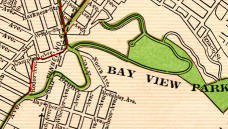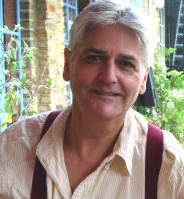Cognitive Mapping and Radio Drama by Alan Beck - Consciousness, Literature and the Arts, Volume 1 Number 2, July 2000
also at http://blackboard.lincoln.ac.uk/bbcswebdav/users/dmeyerdinkgrafe/archive/cog.html
SECTION 9
9.1 Listener positioning
So on to my way-finding through some play scenes. My listener positioning is at the best vantage point, the ego-centered, and this is nearly always a fixed sound centre. (See Forrester, 2000, 3.5 on 'being at the centre of the auditory experience' in the Lifeworld.) The sound mixing and balancing have already been done for me through the mediation of radio, and I am at the optimum listening position in my consummatory field. The fixed sound centre, nearly always the norm in standard production, allows only a limited representation of those 3-D dynamic forms such as we experience in the real world
9.2
And so I constantly maintain orientation - this is key to how I unambiguously process what I hear. It is how I understand the increasing and lessening in volume of the various sound events, especially the dialogue, as being near or far, as characters approaching the centre of the sound picture. A comparison could be made with film, as radio drama directors frequently do in production. Relative positions are mainly, as in film, CU or 'close shot', medium close up shot or MCU, and medium shot or MS, to the 'knees'. (These are microphone positions 2 and 3 - Beck, 1997a, 48-56.) There is also further off (LS 'long shot' - microphone positions 4 and 5). Being compulsorily attuned to the sound centre, I am offered a single-point perspective, certainly in standard production. Nearness and farness are equivalent to painting's changes in tone and colour values in the representation of objects which recede from the viewer.
9.3 'Ingredient X'
So here now are some short scenes from 'Ingredient X', a 1929 radio play by L(awrence) du Garde Peach. This was the first convincingly radiogenic piece, in my opinion. That is, it is the first to make the 'optimum aesthetic use of sound in radio transmission' (using Tim Crook's neat definition), and the first in which some main techniques of radio drama were brought into play together. It was originally a live broadcast, as recording technology did not then exist in the B.B.C. at Savoy Hill, and so the production is lost to us. But even in reading this excerpt, one gets a sense of how the listeners of 1929 were rapidly transported from location to location (storm at sea, African jungle, London board room). The plot concerned capitalist greed and colonialism, as the mysterious 'ingredient x' is exported from Africa via ship for the London rubber market. Storm and revolt bring about disaster, and as we take up the play, the tragedy speeds to its climax (however partially this was achieved in the technology of the time). After this excerpt, there are only five further scenes to the play's end. (The original script is in the B.B.C. Written Archives, Caversham.)
Scene 35
Scene: The Sea
447 FX: (THE STORM SOUNDS ARE NOW VERY LOUD. ALL
DIALOGUE MUST BE SHOUTED.)
448 CAPTAIN: Clear up the port boats!
449 DEAN: Number One's stove in, sir.
450 CAPTAIN: Stand by two and three.
451 FARRER: Starboard boats all jammed by the list, sir.
452 CAPTAIN: Very good, Mr. Farrer. All hands to the port side. Are
your men up on deck, Chief?
453 CHIEF: The second's blowing off steam now.
454 CAPTAIN: Get all hands up at once. See everything clear
forrard, Mr.
Farrer, and -
(FADE)
9.4
I visualise the scene on the ship's bridge in LS or long shot, and the principal character, the Captain, is probably, in production, more foregrounded. The atmos of the storm is 'off', or in the outer frame (as defined in Beck, 1998). If it were not for other factors, my 'viewing' of radio would be that of a fixed stare. The serial ongoingness of talk radio, for example, suggests that turn-taking in dialogue is akin, somewhat, but only somewhat, to the shot-reverse-shot of film dialogue.
9.5
But take the next tense scene, where the traders Bruce and Anderson, have paused in their jungle escape, and whisper to each other:
Scene 36
Scene: The Forrest
455 FX: (THE TOM-TOMS ARE FAINTER)
456 BRUCE: What's that?
457 ANDERSON: Nothing.
458 BRUCE: I thought I heard something in the bush.
459 DOCTOR: So did I.
460 BRUCE: Imagination. Push on. You all right, Doc?
461 DOCTOR: I can manage.
(FADE)
Scene 37
Scene: The Board Room
462 CHAIRMAN: - and now gentlemen, with regard to the proposed issue of fresh debentures. I think we may safely advise the General Meeting to -
(FADE)
9.6
I feel myself at a mid-point between the two-hander realist dialogue in Scene 36, if in standard production they are both at microphone position 2, 'close shot', and their dialogue turns are quite short and regularly paced. Both Bruce and Anderson remain in this 'two-shot' for the short scene. I am not 'turning my head' as in watching a tennis match. I just have a pretty regular two-shot sound picture, maybe fading in and out a little - both characters 'seen' in 'head and shoulders', or 'head', frontally on to me in a triangular configuration. (The film spectator is 'controlled and confined by framing and camera movements to what should be visually *salient* to him' - Tarnay, 1997.)
In terms of paraproxemics (apparent interpersonal distance between radio's performers and myself), that is how close I am to these characters, certainly in relation to the depth cues of dialogue. They are not shouting as in the previous scene. L. du Garde Peach, already in 1929, and so soon after the first UK experiment in 1922, had the skill to contrast listener's positioning here, rapidly from scene to scene.
Another question is raised for the moment. Does my ego-centred position equal that of the disembodied camera 'eye' / 'I'? (For some later examples from Hitchcock, see William Rothman's book, The "I" of the Camera - Rothman, 1988.) Certainly Tarnay's 'controlling camera' analogy should not be pushed too far for radio drama. But there is not the space to follow through here this tantalising issue about apparatus theory. (Forrester, 2000, section 5, takes up my points about the listener's sound centre in radio drama.)
I maintain my sense of direction because the play's information system severely limits me to a few salient landmarks (STORM SOUNDS and TOM-TOMS). They have clarity of display. Because of radio's economy and structuring hierarchy of sounds, I can extract these landmarks with maximum ease and most efficient attention.
To SECTION 10 - Objects in outline Gestalts


Academic material on this site is  Alan Beck
is licensed under a Creative Commons Attribution-Non-Commercial-Share
Alike 2.0 UK: England & Wales License.
Alan Beck
is licensed under a Creative Commons Attribution-Non-Commercial-Share
Alike 2.0 UK: England & Wales License.
See more of Alan Beck's work.
To the WELCOME PAGE for Alan Beck's site.
Learn about radio drama on this site along with my book - Beck, Alan, Radio Acting, London: A & C Black ISBN 0-7136-4631-4
Available on Amazon. CLICK HERE.
Any opinions expressed in this site are the personal opinions of the owner of the site. IF YOU HAVE COMMENTS, PLEASE EMAIL TO : [email protected]
